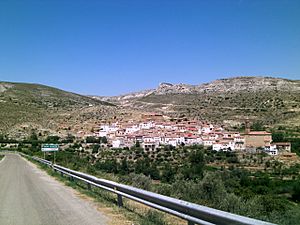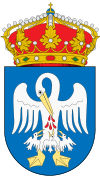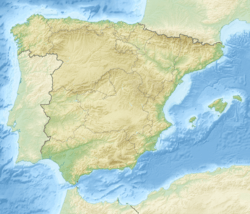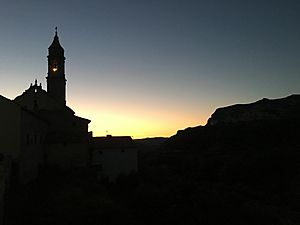Seno, Aragon facts for kids
Quick facts for kids
Seno
|
||
|---|---|---|
 |
||
|
||
| Country | Spain | |
| Autonomous community | Aragon | |
| Province | Teruel | |
| Comarca | Bajo Aragón | |
| Area | ||
| • Total | 17.9 km2 (6.9 sq mi) | |
| Elevation | 792 m (2,598 ft) | |
| Population
(2018)
|
||
| • Total | 39 | |
| Time zone | UTC+1 (CET) | |
| • Summer (DST) | UTC+2 (CEST) | |
Seno is a small town, also called a municipality, located in the Bajo Aragon area of Spain. It is close to Maestrazgo in the province of Teruel, which is part of Aragon. Seno sits high up, at 792 meters (about 2,598 feet) above sea level. In 2018, only 39 people lived there, making it a very small community.
Seno is known for its interesting Church, built in the 18th century, which is dedicated to Saint Helen. There is also a special fountain and a small church (called an hermitage) dedicated to Saint Valero. A local story says that Saint Valero, a bishop, was once thirsty here. He prayed to God and hit the ground with his staff, and a spring of water appeared!
Contents
Discovering Seno's Geography
The houses in Seno are built closely together around the Church of Santa Elena (Saint Helen). This church is an old building from the 18th century, made of stone. It has a tall, slender tower built in the Mudejar style, which is a mix of Christian and Islamic art. People in the town helped pay for its construction.
Inside the church, you can see beautiful paintings on the main altar. These paintings show eight women from the Old Testament and Saint Helen. There is also a special dome dedicated to the Holy Spirit. Sadly, some parts were damaged during the Spanish Civil War. In the same square as the church, you will find the town hall, which was finished in 1785. It has a special area at the bottom where people play a traditional sport called "ball-hand."
The Hermitage of San Valero
A little way from the town is the hermitage of San Valero, who is the town's patron saint. This hermitage was also built in the 18th century, right next to the San Valero spring. People believe the water from this spring has healing powers. The water always stays at the same temperature, about 15°C (59°F), all year round.
The old story says that Saint Valero, a bishop from Zaragoza in the 4th century, was traveling through this valley when he was exiled. He couldn't find any water, so he struck the ground with his staff at this spot, and the spring appeared.
Water and Wildlife in Seno
Seno has many important water springs, up to 12 of them! These springs provide water for the whole region. They also help local farmers grow many crops, like peaches, almonds, and olives, creating a rich farming area.
The mountains around Seno are home to many birds of prey, like griffon vultures. You can also find a group of Hispanic goats living there.
A short distance north of the village, about 300 meters away, is a neighborhood called Paris. Today, almost no one lives there.
Seno's Long History
Seno has a very old history. The first signs of people living here come from the Stone Age (Neolithic period), the Bronze Age, and the Iron Age. For example, an old iron mine called Valdestrada dates back to the 5th century BC. You can also find remains from the Iberian people (like the village of Vallipón, which was destroyed by Roman soldiers) and from Muslim and Templar forts, such as near the Fuente del Salz spring.
Early Records and Templar Influence
Seno was first mentioned in official papers in 1194, in a document about the town of Camarón. During the 12th and 13th centuries, it appeared in Templar and Sanjuanista documents as a "castellar," which means a place with a castle or fort. This suggests that the first building in Seno was likely a defense tower, probably built by the Knights Templar, a famous group of medieval knights. Many Templar symbols, forts, and crosses can be found throughout this area. The nearby fortress of Castellote was an important Templar center, given to the Templars by King Alfonso II in 1196.
Becoming a "Villa"
For a long time, Seno was connected to the nearby town of Castellote. After some disagreements, King Charles II of Spain signed a document to separate Seno. However, this separation didn't fully happen until July 23, 1789, when King Charles IV officially made Seno its own "Villa," or town.
The Church of Saint Helen
The parish church, dedicated to Saint Helen, is a beautiful example of Baroque architecture. It was built between 1763 and 1771 under the guidance of a master builder named Juan España. It stands on the site of an older church from 1650. An inscription on its entrance says, "Charitas me fecit," meaning "Charity made me," showing it was built with donations from the people. The amazing paintings in the main altar area are very special. The church's bell, from the 18th century, is also quite rare in the Lower Aragon region because most bells were destroyed during the Civil War.
Seno During the Spanish Civil War
During the Spanish Civil War (1936–1939), Seno was lucky and was not bombed, unlike many other towns in the area. This meant its people did not suffer directly from the war's harshness. However, the church was used as a storage place by an anti-fascist group, and much of its contents were burned. Luckily, the main bell in the tower was saved.
In 1938, a group of Republican soldiers set up a defense point on a mountain above the town, over 1,000 meters high. They built many trenches and forts there. On March 25, 1938, during a major battle where Franco's troops divided Republican Spain, the 83rd division, led by General Martín Alonso, took over Seno. They finally pushed the government troops out of their mountain stronghold.
Recent History
On February 1, 2009, the Bishop of Teruel and Albarracín visited Seno. He blessed the restored Parish Church of Santa Elena. The restoration was made possible by donations from the people of Seno, the General Council of Aragon, and the Seno Town Hall. In 2016, new lights were installed to illuminate the church tower at night.
Fun Festivities and Events
Seno celebrates its main festivals in honor of its patron saints.
- Saint Valero: The patron saint festivities for Saint Valero are held on the last weekend of January, around January 29th.
- Saint Helen and San Roque: Another important celebration happens on August 14th, 15th, and 16th, honoring Saint Helen (to whom the church is dedicated) and San Roque.
Throughout the year, the "Senerico Sports Club" organizes two popular events that the whole town enjoys:
- The BTT Senerica: This is a classic mountain biking event held at the end of July. It has two routes, a short one and a long one, both of which are challenging.
- The Hiker Route: In early October, there's a hiking event, also with short and long routes. It ends with a friendly meal where everyone gets together.
How Seno's Population Has Changed
Over the last century, Seno has lost almost 90% of its population. This was mainly due to many people moving to bigger industrial cities like Zaragoza, Valencia, and Barcelona in the 1960s and 1970s to find work. You can see how the number of people living in Seno has changed over the years in the table below:
| 1900 | 1910 | 1920 | 1930 | 1940 | 1950 | 1960 | 1970 | 1981 | 1991 | 2007 | 2014 | 2015 |
|---|---|---|---|---|---|---|---|---|---|---|---|---|
| 351 | 422 | 332 | 332 | 291 | 231 | 195 | 105 | 61 | 48 | 45 | 42 | 43 |
| Source: Spain Statistics Institute -IN- (Spain) | ||||||||||||
Images for kids
See also
 In Spanish: Seno (Teruel) para niños
In Spanish: Seno (Teruel) para niños






